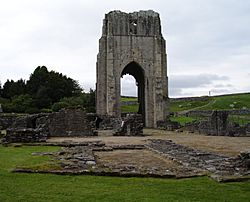Shap Abbey facts for kids

Shap Abbey
|
|
| Monastery information | |
|---|---|
| Full name | Abbey church of St. Mary Magdalene |
| Other names | Shap Abbey |
| Order | Premonstratensian |
| Established | 1190 near Kendal, 1199 on this site |
| Disestablished | 1540 |
| Diocese | Carlisle |
| Site | |
| Location | Shap Rural, Cumbria, England |
| Coordinates | 54°31′49″N 02°42′01″W / 54.53028°N 2.70028°W |
| Visible remains | large tower and outline of conventual buildings |
| Public access | Yes, English Heritage |
Shap Abbey was once a special home for a group of monks called Premonstratensians. They were a type of monk who followed strict rules. The abbey is located by the River Lowther in a quiet area called Shap Rural, about 1.5 miles (2.4 km) from the village of Shap in Cumbria, England. Today, English Heritage looks after the site, with help from the Lake District National Park.
Contents
What is Shap Abbey?
Shap Abbey was a monastery, which is a place where monks or nuns live together. They dedicate their lives to religious study and prayer. The monks at Shap Abbey belonged to the Premonstratensian order. This order was founded in France in the 1100s. They were also known as "White Canons" because of the color of their robes.
A Look at Shap Abbey's History
How Shap Abbey Started
Shap Abbey was not always in its current spot. The group of monks first started their community in 1190 near Kendal, about 20 miles (32 km) south. But in 1199, they moved to the place we know today. This new location was then called 'Hepp'. The name 'Hepp' meant 'a heap' or 'a pile'. Over the next 100 years, the name slowly changed to "Shap," which is what we call it now.
Famous People at the Abbey
One important person who lived at Shap Abbey was Richard Redman. He was an abbot, which is the head of an abbey. Richard Redman was very successful. He later became a bishop in different places, including Bishop of St Asaph (around 1471), Bishop of Exeter (1495), and Bishop of Ely (1501). He passed away in 1505. You can still see a grand monument built for him in Ely Cathedral.
The End of Shap Abbey
During the 1500s, many monasteries in England were closed down. This time was called the Dissolution of the Monasteries. Shap Abbey managed to stay open a little longer than some others. However, it was eventually closed in 1540. After it closed, the abbey was sold to the Governor of Carlisle.
Most of the abbey buildings were taken apart after it closed. People used the stones to build other things. For example, some stones were used to build Shap Market Hall in the late 1600s. Many beautiful carved stones were also moved to help build Lowther Castle. Some parts of the abbey were even turned into a farmhouse and barns. These parts have stayed mostly the same for the last 400 years as they were used by a working farm.
Visiting Shap Abbey Today
Today, you can visit the ruins of Shap Abbey. The site is open to everyone, and you don't need to pay to get in. While most of the buildings are gone, you can still see the impressive remains of the main tower. You can also clearly see the outlines of where the other buildings used to stand.
There is a car park available for visitors. A short path leads from the car park across fields to a small chapel called Keld Chapel. This chapel was built in the 1500s and is now looked after by the National Trust.
Images for kids



